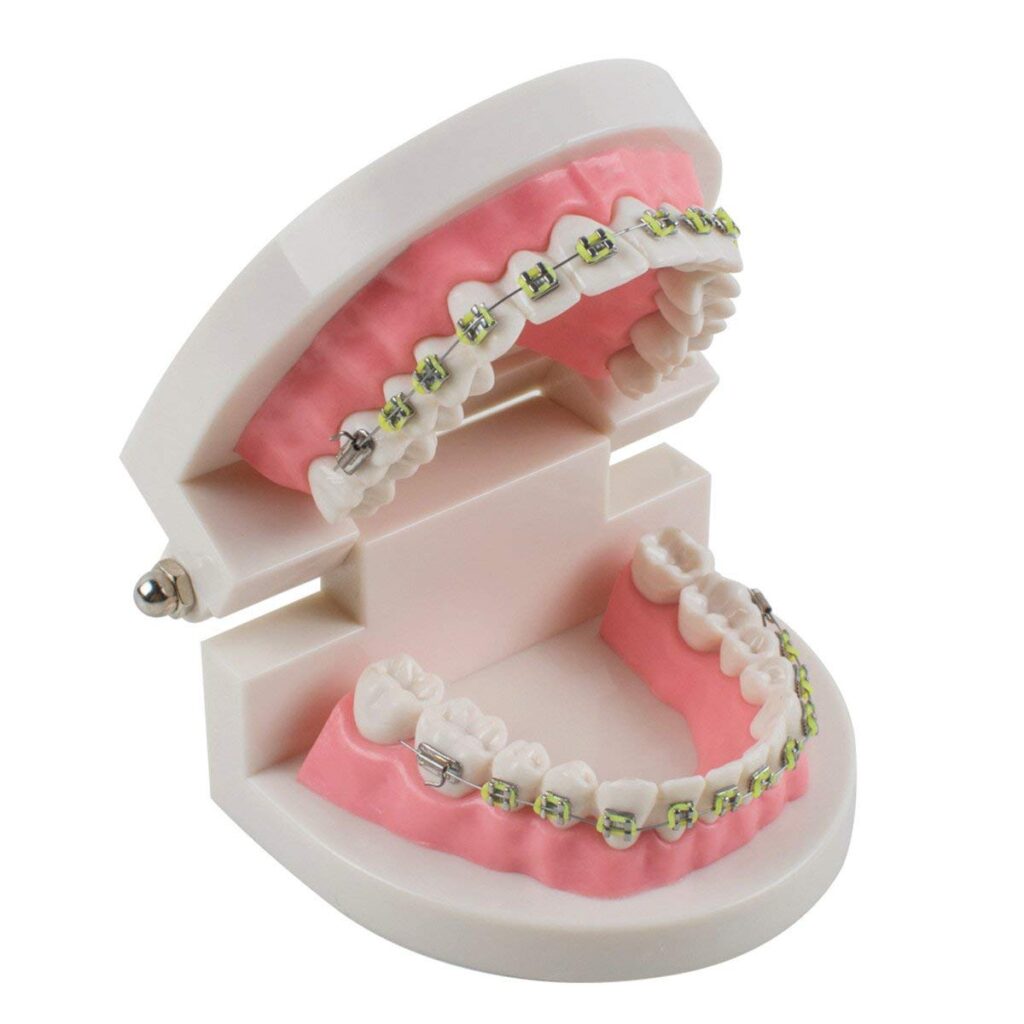BRACES

WHAT YOU NEED TO KNOW ABOUT BRACES
Braces, also known as orthodontic appliances, are dental devices that are used to correct misaligned teeth and jaws. They consist of metal brackets that are attached to the teeth and connected by wires and rubber bands that apply gentle pressure to move the teeth into the desired position. There are different types of braces available, including traditional metal braces, ceramic braces, lingual braces, and clear aligners. The length of time that braces need to be worn varies depending on the severity of the dental issues being addressed, but most people wear them for a period of 1 to 3 years. It’s important to follow your orthodontist’s instructions on how to care for your braces and maintain good oral hygiene throughout the treatment process.
BEnefits
Wearing braces can have a number of benefits for your oral health and overall well-being. By correcting misaligned teeth and jaws, braces can improve your bite, making it easier to chew food and speak clearly. They can also make it easier to maintain good oral hygiene, as straighter teeth are easier to brush and floss effectively. Additionally, straighter teeth can improve your self-confidence and make you feel more comfortable smiling and speaking in social situations. By addressing dental issues early on with braces, you may be able to prevent more serious problems from developing later in life, such as gum disease, tooth decay, and jaw pain. With proper care and maintenance, braces can help you achieve a healthier, more beautiful smile that you can enjoy for years to come.

PRICES
Active Self-Ligating Braces
$1,500 USD
Damon Clear Braces
$3,500 USD
Clear Aligners
$5,500 USD
Acrylic Retainers
$120 USD PER ARCH
Night Guard
$120 USD PER ARCH
INITIAL CONSULTATION AND PLANNING
The first step is to schedule an appointment with an orthodontist. During this initial visit, the orthodontist will evaluate your teeth and jaw to determine if braces are the right option for you. You will also discuss your needs and expectations with the orthodontist.
TREATMENT PLANNING
After the initial evaluation, the orthodontist will develop a detailed treatment plan. This may involve taking X-rays, photographs, and molds of your teeth to get a comprehensive picture of your dental structure. Using this information, the orthodontist will create a personalized treatment plan to correct your malocclusion issues.
PLACEMENT OF BRACES
Once the treatment plan is developed, the next step is to have the braces placed on your teeth. During this procedure, your teeth will be cleaned and dried, and a special adhesive will be used to attach the brackets to your teeth. Then, an archwire will be inserted through the brackets and secured with elastic or metal ligatures.
ADJUSTMENTS AND FOLLOW-UP
After the braces are placed, you will require regular visits to the orthodontist for adjustments. These adjustments involve changing the archwires or ligatures to apply pressure and gradually move your teeth into the correct position. These follow-up visits typically occur every four to six weeks, depending on your case.
CARE AND MAINTENANCE
Throughout the braces treatment, it’s important to maintain good oral hygiene. This involves brushing your teeth after every meal and using dental floss daily. You may also be advised to avoid certain sticky or hard foods that could damage the braces or wires.
REMOVAL OF BRACES AND USE OF RETAINERS
Once your teeth have achieved the desired position, the braces will be removed. This process is quick and usually painless. After the braces are removed, retainers will be placed, which are devices designed to maintain your teeth in their new position while the tissues stabilize. You may need to wear the retainers for a specified period, both during the day and at night.
TREATMENT PROCESS
Reading the steps of a dental treatment is of utmost importance to ensure a successful outcome. Each step of the treatment is crucial and builds upon the previous one. Understanding the sequence of events allows the patient to be prepared for what is to come and to be aware of any potential risks or complications. By reading the steps, patients can ask questions and clarify any doubts they may have, which in turn allows them to feel more comfortable and confident during the procedure. Additionally, knowing the steps of the treatment helps patients to take an active role in their oral health and to be aware of the long-term maintenance required for a healthy and beautiful smile.
REVIEWS

Will definitely be coming back for future dental work.
And I do often get several compliments on my “Mexican crown “… Thank you Dr. Jonathan for such a wonderful job, very happy with it !
Dr. Bernabe was fantastic! Very professional, gentle and compassionate. I almost fell asleep in his dental chair.
While I was going through my tooth restoration, my husband got his teeth cleaned with Dr. Mariana. Also great experience for him. We were both very impressed with the service and the staff.
Not wishing anyone a dental problems but if you get one in Cancun, go to this office. Highly recommend!
Dr. Xavier is very professional doctor. Assistant Mr. Jonathan is very good too. Reception ladies are fantastic. I visited doctor with my daughter and both of us are very satisfied with the results of our treatments. Prices are very reasonable! Thank You! We will definitely come back!
Thank You that You Care about people and their smiles!
I arrived at the office feeling anxious and in pain, but the team there immediately put me at ease. Dr. Bernabe was highly skilled and efficient, quickly taking my x-ray and diagnosing the issue before performing the extraction with expertise. I was out of the office by 9:30am, feeling relieved and grateful for the prompt care I had received.
Gretter from the front desk was also a valuable asset to the team, making herself available to translate during the procedure and ensuring that I received the best care possible. She was professional and compassionate, going above and beyond to make me feel comfortable and supported throughout the process.
Overall, my experience at the dental office was excellent. Thanks to their efforts, I was able to enjoy the rest of my vacation without any further discomfort. Despite the challenging circumstances of my vacation, the team there was able to provide me with prompt, efficient, and compassionate care that allowed me to enjoy the rest of my trip without further discomfort. I highly recommend this dental office to anyone in need of dental care – they truly went above and beyond to help me in my time of need.
their service and overall quality of work!!! The best extraction experience ever!!! Would highly recommend this place….
Just Ask for DR.ARTUR!!!
CONTACT US
Get in touch and contact us through our contact form and networks! At Cancun Dental Care our goal is to always be in touch with our clients, answer any questions that may arise and give you the best possible service.


